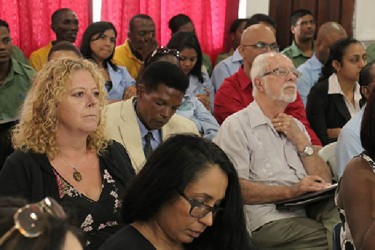Minister of Natural Resources and the Environment, Robert Persaud acknowledged on Friday that more had to be done to monitor mining activities for environmental transgressions.
Speaking at a stakeholder’s consultation to discuss and highlight his ministry’s strategic vision for 2014, Persaud noted, “We can have development and we can develop our natural resources and we can do so in a way that these activities do not jeopardize our environment. It would be naive to say that in our quest for development that there would not be some disruption and we recognise that.” Persaud said economic development could only escalate at the expense of an environmental compromise, where some natural resources’ sustainability could be jeopardized. “…But… we cannot be reckless and be blind to the challenges that may come about as we move forward,” he said.

He noted that there were two clear paths. “We either develop our natural resources or we do not proceed in that direction and focus only on the issue of preservation of the environment,” he said, while declaring that the right approach would be conservation-based as this would reduce the imbalance.
“…And if we continue to grow at a rate of four to five per cent per annum it will take 20 years for us to achieve that, only if we maintain that level… We are not going to achieve that by talking only and we will not achieve that by not having a strategic outlook…,” he added.
Persaud stated that an area of weakness which has hounded the ministry’s advancement was in the execution of its policies and the regulations. “In that area—in execution and implementation we have been inadequate,” he told stakeholders, urging them to partner with the different agencies and the ministry to implement environmental regulations.
In mining, he said, agencies had failed to implement a rigid focus by monitoring mining activities. “It is an area [in which] we have been weak,” he said, while adding that the forestry sector also demanded greater diligence. “No one needs to highlight or repeat the fact that our agencies have not been able to fully ensure that there is compliance in the mining sector,” he said, adding that strategic partnerships with NGOs, private sector bodies and communities would help to sustain the environment.
He added that the ministry and its agencies were also looking at utilizing technology to be up-to-date with environmental occurrences in far-flung areas. He said satellite image monitoring could track forest change. He also urged private aircraft companies, along with the Guyana Defence Force, to install cameras to have a better understanding of what was happening so “that they don’t have to wait until an issue arises,”
Country Manager of the World Wildlife Fund (WWF) Patrick Williams said the WWF was also seeking to introduce responsible mining in the sector by training miners and creating awareness of developing a greener economy. He said some miners were unaware of issues that affect the environment.
He referred to a study of goldsmiths around Georgetown, first publicised last year, which revealed that some goldsmiths were burning mercury and not using protective gear.
Williams indicated that the WWF was drafting new mining regulations because some of the regulations were outdated and useless.
Another issue on the WWF strategic plan is appropriate management of land space. Williams pointed out that conservation of resources and economic development activities were clashing since many activities occur within the same land space. He said the introduction of land use planning would release tremendous benefits. Meanwhile, the Environmental Protection Agency (EPA) is seeking to strengthen partnerships with government organisations and NGOs while pursuing increased environmental management compliance. It is also looking to implement a litter prevention and wildlife management plan, an EPA official said.
Deputy Commissioner of the Guyana Geology and Mines Commission (GGMC), Newell Dennison zeroed in on the agency’s response to the mining sector as regards solid waste, waste water and industrial waste. He said since it was expensive to transport waste from mining areas to the city, miners would usually dump human excreta and litter near landings and waterways. He said the improper disposal was placing great strains on the environment.
The improper disposal of the water waste, he said, usually compromises the soil cover of the land while escalating the risk of erosion. He noted that industrial waste damages both the water and land.
The GGMC’s action plan, he said, will seek to create awareness in mining camps and communities, while enforcing the code of practice and the use of remedial actions. He said regulations would be enforced through inspection campaigns.









